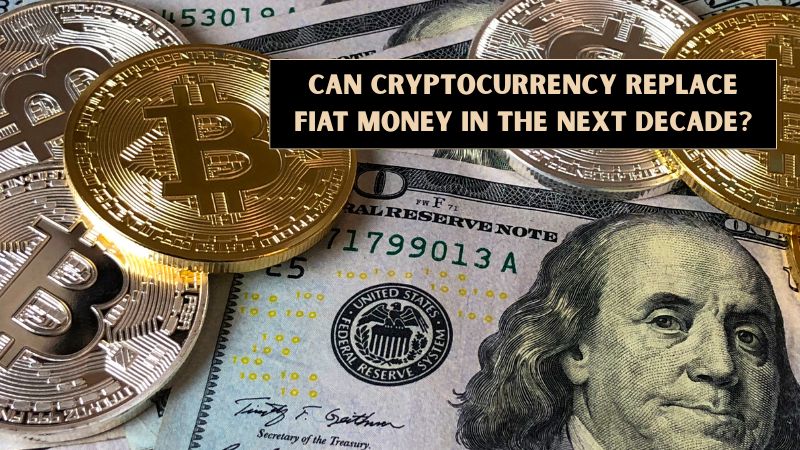Introduction: A New Age of Money?
Cryptocurrency has gone from being a tech geek’s dream to a global buzzword. What started with Bitcoin in 2009 has now evolved into a financial movement. But can this digital money truly replace traditional fiat currencies in the next ten years?
It’s a big question. Replacing fiat money like dollars, euros, or yen would mean changing how the world shops, saves, and spends. Many people are curious, hopeful, or even skeptical about the future of crypto. Let’s explore the possibilities, challenges, and what the next decade might hold.
What Is Cryptocurrency?
Cryptocurrency is a digital or virtual currency that uses cryptography for security. It’s decentralized, meaning it isn’t controlled by any central authority like a bank or government. Instead, it runs on blockchain technology—a distributed ledger system that records transactions transparently.
Popular cryptocurrencies include Bitcoin, Ethereum, and newer coins like Solana and Cardano. These digital currencies are not printed or minted. They’re mined or created through code and computers, making them purely electronic.
What Is Fiat Money?
Fiat money is the legal tender issued by governments. It has value because the government says it does—not because it’s backed by gold or any physical commodity. Your local currency, like the U.S. dollar, Indian rupee, or British pound, is fiat money.
It’s used for everyday things—buying groceries, paying bills, and collecting salaries. Central banks manage its supply and use interest rates or inflation control tools to stabilize economies.
Why People Love Cryptocurrency
Many crypto fans see digital currencies as the future of finance. They offer several benefits over fiat money. For starters, crypto is decentralized and borderless. You can send money across the world in minutes without dealing with banks or exchange rates.
Another major advantage is privacy. While not completely anonymous, crypto offers more privacy than traditional banking. It’s also often faster and cheaper for international transactions.
And then there’s the investment potential. People have seen huge returns in crypto over the past decade, sparking more interest and adoption.
Limitations of Fiat Money
Fiat money has served us well for decades, but it’s not perfect. Governments can print more money when needed, which sometimes leads to inflation or even economic collapse, as seen in Venezuela or Zimbabwe.
Fiat systems also rely heavily on trust—trust that banks won’t fail, governments won’t misuse funds, and financial institutions will act fairly. In many countries, this trust is shaky at best.
For those who live in regions with unstable currencies or limited access to banking, crypto provides a new alternative.
The Volatility Challenge
One of the biggest problems with cryptocurrency is its extreme volatility. Prices can swing wildly in a single day. Bitcoin, for example, has gone from a few dollars to over $60,000 and back down again—often within months.
For crypto to replace fiat money, it needs to be stable. No one wants to be paid in a currency that might lose 30% of its value by the weekend. This instability makes it risky for day-to-day transactions.
Government Regulations Matter
Governments play a key role in how crypto develops. In some countries like El Salvador, Bitcoin has become legal tender. In others like China, crypto is heavily restricted or banned altogether.
Global regulations could either boost or block crypto adoption. If governments create fair rules and frameworks, people will feel more secure using digital currencies. But if governments crack down, it may slow or stop crypto from growing.
Trust in the system often depends on clear legal backing, and right now, crypto lacks consistent global regulation.
Adoption Is Growing Fast
Despite the challenges, crypto is gaining popularity. Big companies like Tesla, Microsoft, and PayPal accept crypto payments. Countries are exploring central bank digital currencies (CBDCs), which are government-backed cryptos.
More people now own digital wallets and use crypto for real-world purchases. In developing nations, it’s being used to combat inflation and access financial services.
Younger generations are especially open to using crypto, seeing it as innovative and future-friendly. As technology becomes more user-friendly, mass adoption seems more likely.
Can Crypto Replace All Fiat Money?
Replacing all fiat currencies is a big leap. It’s unlikely that crypto will fully take over in the next decade, but it could exist alongside fiat money.
Hybrid systems may emerge. For example, you might use government-issued digital currencies for basic needs and cryptocurrencies for savings, trading, or global payments.
Central banks are also working on their own digital currencies, which combine the benefits of crypto with the stability of fiat. These might bridge the gap between old and new systems.
Key Challenges That Remain
For crypto to replace fiat, several hurdles must be cleared. These include price stability, energy usage (especially in Bitcoin mining), regulation, and public trust.
Security is another concern. While blockchain is secure, hacks and scams still occur in crypto exchanges and wallets.
And not everyone is tech-savvy. Crypto can be confusing for the average person. For mass adoption, it needs to be as easy to use as a debit card or a mobile wallet.
The Role of Stablecoins
Stablecoins are a special type of cryptocurrency designed to be less volatile. They’re usually backed by real-world assets like fiat money or commodities.
Tether, USD Coin, and DAI are examples. These aim to combine the speed and decentralization of crypto with the stability of traditional currencies.
Stablecoins might be a strong contender in replacing fiat for everyday use because they address the issue of price fluctuation while keeping the benefits of digital currencies.
What the Next Decade Might Look Like
Over the next 10 years, we may not see crypto entirely replacing fiat, but major shifts will likely occur. Governments may launch more CBDCs. Businesses will likely accept crypto more widely. Crypto education will improve, and new technologies may make it safer and easier to use.
We might live in a world where multiple types of money exist side by side. People may choose the type that works best for their needs, whether it’s crypto, fiat, or a digital version of fiat.
The key is balance, innovation, and regulation that supports growth while protecting users.
Conclusion: A Future Worth Watching
Cryptocurrency has already changed how we think about money. While it may not fully replace fiat money in the next decade, it will definitely play a much bigger role in our financial lives.
We are headed toward a hybrid future, where traditional money and digital assets coexist. The pace of this change depends on governments, technology, market stability, and public trust.
The next decade will be crucial. Keep an eye on crypto—it’s not just a trend; it’s a revolution in progress.


